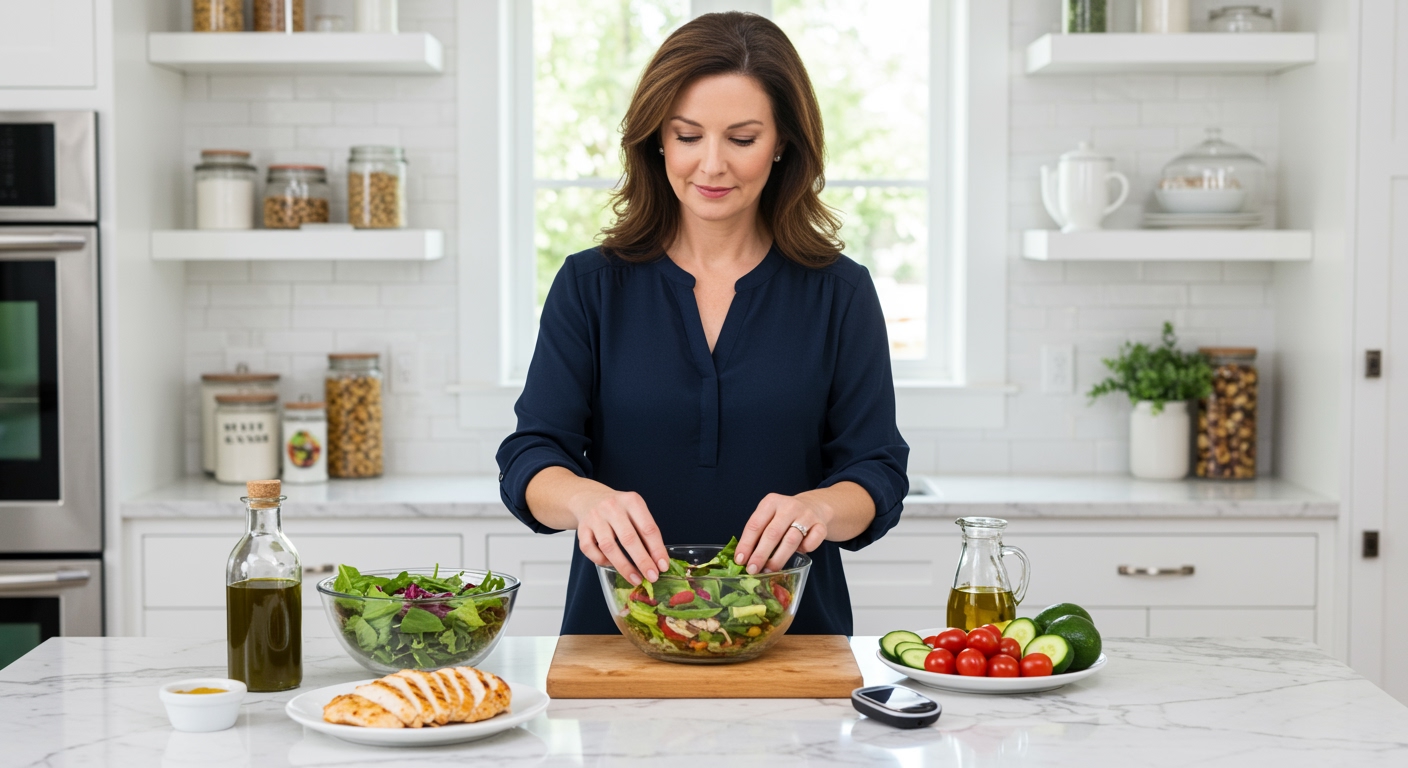✪ Key Takeaway: Chicken salad can be good for diabetes when made with fresh ingredients, healthy fats, and no added sugars.
Introduction
You grab a chicken salad sandwich thinking you made a healthy choice for your diabetes.
Then your blood sugar spikes higher than after eating a candy bar, and you wonder what went wrong with your supposedly smart meal decision.
Hi, I am Abdur, your nutrition coach, and today I am going to explain exactly why some chicken salads help manage diabetes while others send your glucose levels through the roof.
What Makes Chicken Salad Diabetes-Friendly?
The protein content in chicken makes it naturally beneficial for blood sugar control.
Protein slows down digestion and helps prevent rapid glucose spikes that damage your blood vessels over time.
A 3-ounce serving of chicken breast provides about 26 grams of high-quality protein with zero carbohydrates.
This protein triggers the release of incretin hormones like GLP-1, which signal your pancreas to produce insulin only when blood sugar rises.
The healthy fats from ingredients like olive oil or avocado further slow carbohydrate absorption in your small intestine.
When you combine protein and healthy fats with fiber-rich vegetables, you create a meal that promotes steady blood sugar levels for hours.
Research shows that meals containing at least 20 grams of protein can reduce post-meal glucose spikes by up to 30 percent compared to high-carb meals.
✪ Pro Tip: Aim for at least 20 grams of protein in your chicken salad to maximize blood sugar benefits.
Which Chicken Salad Ingredients Spike Blood Sugar?
The biggest culprit in most commercial chicken salads is added sugar hiding in the mayonnaise or dressing.
Many store-bought versions contain high fructose corn syrup, which bypasses normal glucose regulation and gets converted directly to fat in your liver.
Dried fruits like cranberries or raisins pack concentrated sugar that hits your bloodstream faster than fresh fruit.
Just two tablespoons of dried cranberries contain about 16 grams of sugar, equivalent to four teaspoons of table sugar.
Sweet ingredients like honey mustard or sweet pickle relish add hidden carbohydrates that accumulate quickly.
The bread or crackers served with chicken salad often contain refined flour that converts to glucose within minutes of eating.
Even seemingly innocent additions like grapes or apples can push your total carb count too high when combined with other sugary ingredients.
✪ Fact: Commercial chicken salads can contain up to 25 grams of hidden sugars per serving.
How Should You Prepare Diabetes-Safe Chicken Salad?
Start with plain cooked chicken without breading or sugary marinades that add unnecessary carbohydrates.
Grilled, baked, or poached chicken breast provides the cleanest protein source without hidden ingredients.
Replace regular mayonnaise with avocado-based dressing or plain Greek yogurt mixed with herbs and spices.
Greek yogurt provides additional protein while delivering probiotics that may improve insulin sensitivity over time.
Add non-starchy vegetables like celery, bell peppers, cucumber, and leafy greens to increase fiber without raising blood sugar.
These vegetables provide essential nutrients while their fiber content slows glucose absorption in your digestive tract.
Season with herbs and spices like turmeric, garlic, and black pepper instead of sweet condiments or dressings.
✪ Note: Greek yogurt contains twice the protein of regular yogurt with half the sugar content.
What About Portion Sizes And Timing?
A proper serving of chicken salad for diabetes management should contain about 4-6 ounces of chicken with plenty of vegetables.
This provides roughly 35-50 grams of protein, which helps maintain stable blood sugar for 3-4 hours after eating.
Eating chicken salad as your main meal rather than a side dish ensures you get enough protein to impact glucose metabolism.
The timing of your meal matters because protein sensitivity varies throughout the day based on your circadian rhythms.
Your body processes protein most efficiently during daylight hours, making lunch an ideal time for chicken salad.
Pairing your chicken salad with a small portion of healthy fats like nuts or olive oil helps extend the blood sugar benefits.
Monitor your individual response by checking blood glucose 1-2 hours after eating to understand how your body handles different ingredient combinations.
✪ Pro Tip: Test your blood sugar 90 minutes after eating to find your personal chicken salad sweet spot.
The Bottom Line
Chicken salad can absolutely be part of your diabetes management plan when you choose the right ingredients and avoid hidden sugars.
The difference between medicine and poison is often just the dose and preparation, and this principle applies perfectly to chicken salad for diabetes.
I would love to hear about your experience with chicken salad and blood sugar management, so please share your questions or success stories in the comments below.
References
At NutritionCrown, we use quality and credible sources to ensure our content is accurate and trustworthy. Below are the sources referenced in creating this article:





